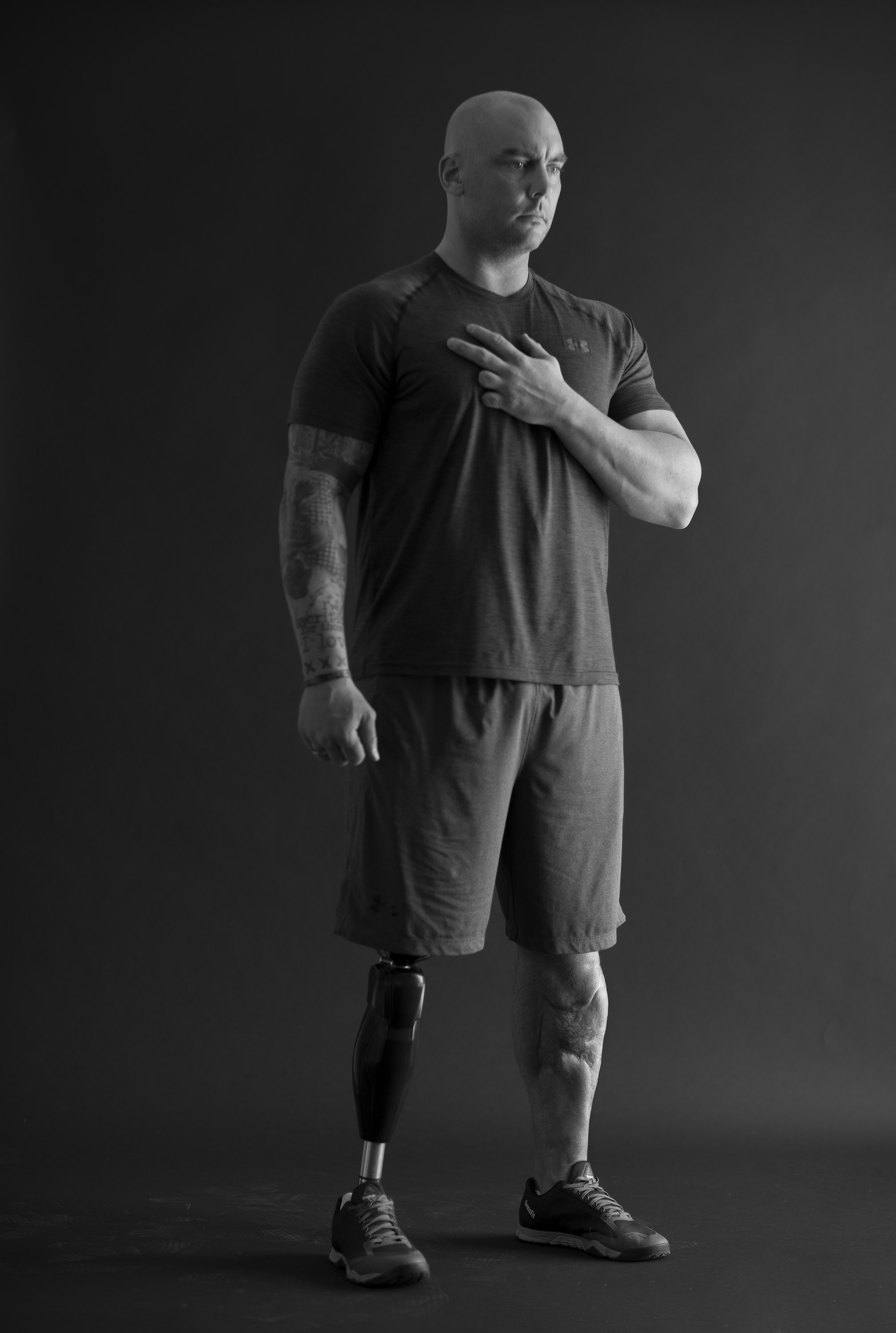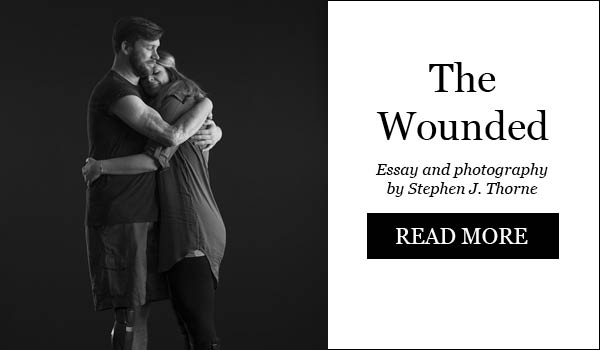
Searching for mines, bombs and IEDs was Étienne Aubé’s specialty. Then a motherlode changed his life.
Story and photography by Stephen J. Thorne
Sergeant Étienne Aubé had a bad feeling about the compound he was standing in near Kandahar, Afghanistan, on July 16, 2009, so the 28-year-old field engineer from Drummondville, Que., ordered everyone out. Then he got blown up.
A section commander with 5 Combat Engineer Regiment, Aubé would be long dead now except for the fact that only two of the multiple bombs linked by daisy chain beneath his feet and immediately around him went off.
So instead of white lights, angels and pearly gates, Aubé was lying on a mud floor staring up at the ceiling where his right foot, still in its boot, was embedded.
He had led a K9 unit in search of improvised explosive devices (IEDs), mines and bombs. He had found one alright, and by ordering the rest of the platoon he was attached to out of the compound, he had likely saved numerous lives.
Aubé was three months into a seven-month Afghanistan tour, his second.
“It was thrilling work,” he says. “But, honestly, I think I was addicted to it, to the adrenaline. We’d come back to the forward operating base and we’d be laughing.
“It was fun, but when we’d go to sleep at night we’d think about it [and realize] ‘It was close today.’”
Attached to 30-member platoons of the Royal 22nd Regiment (Vandoos), Aubé’s unit would use dogs, metal detectors, intuition, experience and good old common sense.
They had found weapons and ammunition caches, booby traps, pressure plates, remotely controlled bombs, unexploded ordnance and IEDs of all sorts. It was all intended for them and other members of NATO’s Kabul-headquartered International Security Assistance Force.
Patrolling on foot, they would find something explosive every few days. Aubé alone had discovered three IEDs in the weeks before the motherlode that changed his life. Demolition teams would blow up the discoveries and Aubé’s crew would move on.
They had been deployed by helicopter on July 15 for a two-day operation around the village of Nakhonay, southwest of Kandahar. Accompanied by Afghan National Army troops, they were to secure the insurgent-heavy area for elections the following month.
Weather had delayed the Canadians’ deployment by two days. The allied Afghan troops were already there and waiting for them. Aubé figures the insurgents got the hint or had been warned an operation was imminent.
On Wednesday, their first day out, they were in a firefight and found weapons caches, unexploded ordinance and pressure plates. Around 5 p.m., Private Sébastien Courcy, a 26-year-old reconnaissance soldier with the Vandoos, was killed by an IED in the hills nearby.
At 5 a.m. the next day, they moved on a compound 400 metres from their bivouac.
“As soon as we got there, I saw that it was pretty weird,” recalls Aubé. “There was nobody there; there was a fire still burning. We found pants full of blood. We found pressure plates. I could see explosives and IED components inside.
“We confirmed an IED too—an anti-tank mine—near this compound. It was really weird for me. There were like 40 of us in this compound. Everybody was there—my section, the ANA. So, I told them: ‘Everybody go out; I will continue by myself.’”

Continued from Military Health Matters e-report No. 11
His mine detector was beeping constantly. A K9 unit stayed with him and the dog was continually indicating explosives. They had taken fire from the compound the night before and spent shell casings were everywhere.
“The place was contaminated. The dog was always sitting [indicating explosives]. I’ve got no tools anymore. So, I asked the guy to go out and I continued my search to confirm an IED.”
He went inside the building and immediately found an artillery shell in the wall. It was a delicate removal; they had already lost one soldier, 35-year-old Corporal Martin Dubé, to a shell that was triggered by a mercury switch, like a carpenter’s level, set to close an electrical contact as soon as the bomb was tilted.
Aubé stepped outside and got some bricks. He was going to stack them so he could lay the artillery shell on them once he got it out of the wall.
He had been in and out of the building four times already and nothing had happened. But this time he was bearing more weight. He stepped on a pressure plate that set off two 81mm Russian mortars.
The bombs were buried just deep enough that they didn’t kill him. The rest of the daisy chain—in front of him and behind—would have taken care of that, had it gone off.
“I felt myself lift in the air. It was like slow motion. Then I realized I’d just blown. I could hear my neck crack when my head hit the roof.”
He landed in the newly formed shell crater beneath him. His radio earphones, still in his ear, came alive with urgent queries about what had happened. His nose, ears and mouth were full of sand. The wind had been knocked out of him. He couldn’t reply.
Vertebrae in his neck were cracked. Two fingers on his left hand were gone. His right foot was gone. His left leg was a mangled mess. He could hear the blood from his femoral artery hitting the wall next to him. He was burned.
“I said to myself, ‘You have to calm down,’ because I was panicking right about then. I was thinking I was dying. Then I felt someone with me who tried to calm me. He told me: ‘If you die, it’s OK. I’m here. If you live, you will be fine. You can do it.’ It was my uncle, who had just passed away a month before. I calmed myself.
“I wasn’t a believer before this, but I know now we have a guardian angel to take care of us.”
It felt like five minutes but within about 10 seconds, a soldier was at his side. Aubé told the others to stay out in case there were other, remotely controlled, bombs the enemy was waiting to detonate.
“I was looking at my leg and I could see my foot was gone,” he recalls. “They found it in the roof with my boot, my brand-new Converse boot. My foot was still inside. So, I could see that it was gone but my other one was still there.
“The femoral artery was severed. The pain was unbelievable.”
Other soldiers—even the medic he had met the night before—began to cry. Aubé calmed them down and got them to apply a tourniquet to staunch the bleeding. He was conscious throughout the ordeal.
“I thought to myself, ‘We’re going to see if you’re a real man, because the real challenge begins now. Your life is never going to be like it was; it’s going to be a new life for you.’ I didn’t know what I was in for.”
Two insurgents were filming the whole thing to get a handle on the Vandoos’ evacuation protocols. A sniper killed them both.
After Aubé was evacuated—under fire—the demolition team came with a robot. They found walls strung with wires connecting cases of shells in each corner of the room, along with 10 anti-personnel mines stacked up and a 103mm round buried a metre away from where he lay. “Everything was linked, but it didn’t blow.”
Thus began Aubé’s medical odyssey—nine bags of blood in Kandahar; dropping from 220 pounds to 150 in nine days (25 pounds of leg and 45 pounds of mass); five surgeries in two years. He ultimately lost his right leg just above the knee.
He expected to lose his left leg, too, but they managed to rebuild and save it by screwing bones together, rearranging his calf muscle and grafting skin from his right leg. His top physical condition saved his life and accelerated his recovery. He was out of hospital in just three weeks.
Aubé never contemplated giving up. He had too much to live for, he says: A wife, Julie, and two children— a girl, age 4, and a boy, 2.
He drew inspiration, too, from a 28-year-old friend, Master Corporal Charles Philippe Michaud, who had been wounded in Afghanistan only to die in a Quebec hospital two weeks prior to his incident.
He was told that fewer than five per cent of those suffering wounds like his ever walk again. “I said: ‘Challenge accepted.’”
He was rewarded with a Mention in Dispatches.
Two years of rehabilitation and determination restored his autonomy. He left the military two years ago. He has battled post-traumatic stress injury, fought addiction and struggled through years of darkness.
“It was the saddest part of my life,” he says of those times. He still struggles off and on, but he’s proud of his wounds, proud of his service, proud of his victories, proud of the person he’s become and the life he now lives.
He will be golfing at the Invictus Games in Toronto this fall. He is compassionate; he loves people. He mentors athletes and counsels others facing life challenges.
“I’ve got no regrets. After coming through it, I appreciate life more than I did before. And at the end of my days, I’m going to say it wasn’t easy but I learned a lot and I earned a lot. I wouldn’t change anything. I’d do it again.”
To view more images and read other instalments in Stephen J. Thorne’s Portrait of Inspiration project for Legion Magazine, please click below.

Advertisement












